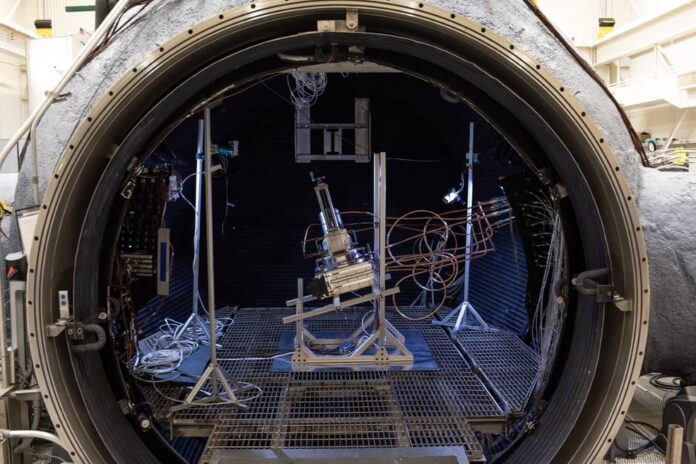Scientists at NASA’s Johnson Space Center in Houston have successfully extracted oxygen from simulated lunar soil in a vacuum environment, marking a major breakthrough in resource utilization technology for future space exploration. The Carbothermal Reduction Demonstration (CaRD) test team conducted the test in conditions similar to those found on the Moon, using a special spherical chamber with a 15-foot diameter called the Dirty Thermal Vacuum Chamber. The team used a high-powered laser to simulate heat from a solar energy concentrator and melted the lunar soil simulant within a carbothermal reactor developed for NASA by Sierra Space Corp.
Carbothermal reduction has been used for decades on Earth to produce items like solar panels and steel by producing carbon monoxide or dioxide using high temperatures. After the soil was heated, the team was able to detect carbon monoxide using a device called the Mass Spectrometer Observing Lunar Operations (MSolo). The same technology that was proved by the CaRD test could be applied to Artemis missions and one day to journeys deeper into our solar system. With the successful completion of this demonstration test, NASA has established that oxygen can be extracted from existing lunar material to provide humans with resources critical for survival and transportation on extraterrestrial worlds.
Establishing a long-term presence on the lunar surface is one of NASA’s primary goals as it works towards sending astronauts to the Moon through Artemis missions. Resources like oxygen are crucial building blocks for making that vision a reality. In addition to using oxygen for breathing, it can also be used as a propellant for transportation, helping lunar visitors stay longer and venture farther.
“This technology has the potential to produce several times its own weight in oxygen per year on the lunar surface, which will enable a sustained human presence and lunar economy,” said Aaron Paz, NASA senior engineer and CaRD project manager at Johnson.
To apply this process to oxygen production on the Moon, a carbothermal reactor needs to be able to hold pressure to keep gases from escaping to space, while still allowing lunar material to travel in and out of the reaction zone. Operating the reactor in a vacuum environment for the CaRD test simulated the conditions at the lunar surface and increased the technical readiness level of the reactor to a six, which means the technology has a fully functional prototype or representational model and is ready to be tested in space.
“This is a big step for developing the architecture to build sustainable human bases on other planets,” said Anastasia Ford, NASA engineer and CaRD test director at Johnson.
NASA’s Lunar Surface Innovation Initiative (LSII) is developing the essential capabilities required for humans and systems to successfully live and operate in multiple environments on the lunar and other planetary body surfaces. The same device that was used for the CaRD test will fly on two upcoming exploration missions to the Moon’s South Pole. The Polar Resources Ice Mining Experiment-1 in 2023 will help scientists search for water, and NASA’s Volatiles Investigating Polar Exploration Rover (VIPER) in November 2024 will explore Mons Mouton, a large flat-topped mountain, to get a close-up view of the location and concentration of water ice and other potential resources.
Through Artemis missions, NASA will land the first woman and the first person of color on the surface of the Moon, paving the way for a long-term lunar presence and serving as a steppingstone for astronauts on the way to Mars. The successful extraction of oxygen from simulated lunar soil is a significant step towards achieving that goal.










